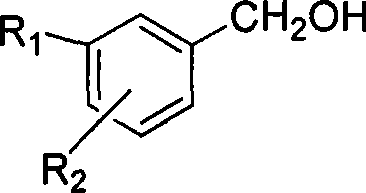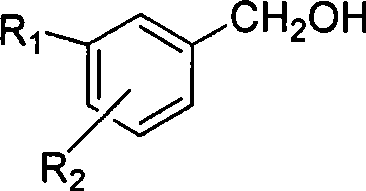Method for synthesizing triphenylphosphine onium salts and halomethyl benzyl ethers compounds
The technology of a halomethyl benzyl ether and a synthesis method, which is applied in the field of organic compound synthesis, can solve the problems of low yield of triphenylphosphonium salts, low purity of intermediates, decomposition of unstable halogenated hydrocarbons, etc. High efficiency and purity, simple process and convenient operation
- Summary
- Abstract
- Description
- Claims
- Application Information
AI Technical Summary
Problems solved by technology
Method used
Image
Examples
Embodiment 1
[0019] In a 250 ml three-necked flask, a thermometer and a stirrer were installed, and hydrogen chloride gas (0.12 mol) was passed into benzyl alcohol (0.1 mol) and paraformaldehyde (0.1 mol), and the reaction temperature was controlled to -10°C. It was then stirred at this temperature for 5 hours. Then n-hexane (100ml) was added at room temperature to separate the layers, and the solvent was evaporated under reduced pressure to obtain the product as a light yellow liquid with a yield of 96% and a purity of 99.1area% (HPLC).
Embodiment 2
[0021] In a 250 ml three-necked flask, install a thermometer and a stirrer, feed 4-fluorobenzyl alcohol (0.1mol) and paraformaldehyde (0.15mol) into hydrogen bromide gas (0.15mol), and control the reaction temperature to -5°C . It was then stirred at this temperature for 4 hours. Then n-hexane (120ml) was added at room temperature to separate the layers, and the solvent was evaporated under reduced pressure to obtain the product as a light yellow liquid with a yield of 98% and a purity of 99.6area% (HPLC).
Embodiment 3
[0023] In a 250 ml three-necked flask, a thermometer and a stirrer were installed, and 4-chlorobenzyl alcohol (0.1mol) and paraformaldehyde (0.25mol) were fed into hydrogen chloride gas (0.14mol), and the reaction temperature was controlled at 0°C. It was then stirred at this temperature for 4 hours. Then n-hexane (110ml) was added at room temperature to separate the layers, and the solvent was evaporated under reduced pressure to obtain the product as a light yellow liquid with a yield of 92% and a purity of 99.2area% (HPLC).
PUM
 Login to View More
Login to View More Abstract
Description
Claims
Application Information
 Login to View More
Login to View More - R&D
- Intellectual Property
- Life Sciences
- Materials
- Tech Scout
- Unparalleled Data Quality
- Higher Quality Content
- 60% Fewer Hallucinations
Browse by: Latest US Patents, China's latest patents, Technical Efficacy Thesaurus, Application Domain, Technology Topic, Popular Technical Reports.
© 2025 PatSnap. All rights reserved.Legal|Privacy policy|Modern Slavery Act Transparency Statement|Sitemap|About US| Contact US: help@patsnap.com



